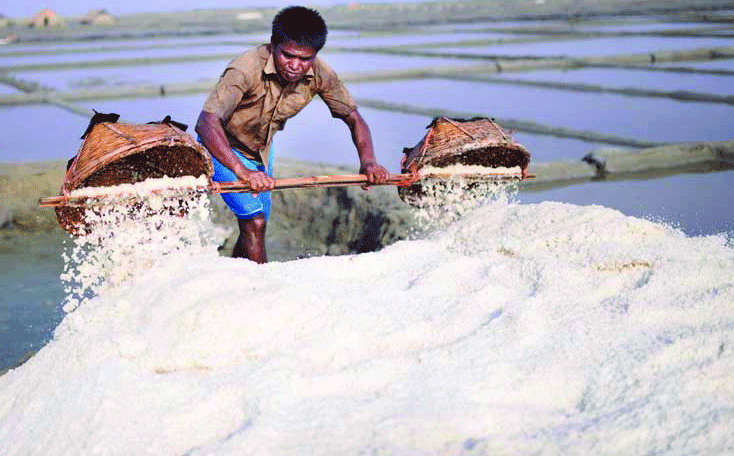Salt syndicate becomes active ahead of Qurbani
Hide and skin traders frustrated
Golam Mostafa Jibon:Though, the government fixes the salt price each year, a syndicate of salt producers and traders have become reckless to increase the price of the goods ahead of Eid-ul-Azha as it is considered as a most important element for producing the rawhides. Consequently, hide and skin traders are in frustration over the matter.
According to the sources, the price of salt, the main ingredient in animal skin preservation, has gone up ahead of the upcoming Eid-ul-Azha, also the second largest festival of the Muslim.
Wholesalers and storekeepers said, prices have risen slightly due to short supply compared to the demand. Although a week ago, salt was sold at Tk 550 per sack, but now it is being sold at Tk 700 per sack. However, the government said, the country has adequate stocks of salt compared to demand. It is also being warned that action would be taken against those, who increase prices by syndicating.
Traders involved in raw leather preservation in Posta area in the capital said, the cost of preserving leather will increase as the price of salt rises before the sacrifice or Qurbani. Besides, many will use less salt than they need to reduce costs. There is a risk of losing the quality of the skin.
Haji Tipu Sultan, a raw leather trader of Posta in Old Dhaka and secretary general of the Bangladesh Hide and Skin Merchant Association said, “Around 50 percent of the raw hides collected throughout the year come during the Eid-ul-Azha. As can be seen every year, the artificial crisis of salt, the main ingredient of skin preservation, is created before the sacrifice. This time the price of salt has been going up for the last few weeks. The sack of salt that used to cost Tk 550, now has to be bought for Tk 700 to Tk 800.”
Al-Amin, a salt retailer in Lalbagh in Old Dhaka said, “I am now selling iodine-free coarse salt (75 kg) used for preserving sacrificial animal skins at Tk 700 to Tk 800 against the price at Tk 550 two weeks ago.
“Wholesalers and storekeepers are charging higher prices, so we are forced to sell at higher prices,” he said adding that “This salt is also used in cattle feeding and dyeing factories.”
Paritosh Kanti Saha, proprietor of Pubali Salt and former president of Bangladesh Salt Mill Owners Association said, “Farmers or salt producers have increased the price of crude salt (raw material of raw salt). Also the supply was low. Due to this, the price of coarse salt used for preserving sacrificial animal skins has increased from Tk 1.5 to Tk 2 per kg. The price of a sack of 75 kg salt has increased by Tk 150. The government claimed that there are adequate stocks of salt. So, why are prices rising?
A former leader of the salt mill owner association said, if the stock was sufficient, then why the price goes up? The information of the government over stock is not accurate. If their data was correct, prices would not have risen in the market due to the crisis.
BSCIC chairman Mushtaq Hasan said, the unscrupulous clique was syndicating and raising the price of salt before the Eid-ul-Azha, which is not logical. Because of the country now has adequate salt reserves compared to the demand.
Mill owners said, prices would not rise, if action is taken against those, who are involved with the syndicating.
According to the Bangladesh Small and Cottage Industries Corporation (BSIC), around 16.51 lakh metric tons of crude salt has been produced in the salt field during the current salt season. Until the arrival of new salt in the current salt season, the stock of old salt was 3.48 lakh tons. In all, the total amount of salt is 19.99 lakh tons till May. Till June 30 this year, the total stock of salt at the field and mill level was 11,00045 crore tons. Besides, dealers, wholesalers and retailers located in different districts and upazilas of the country have adequate salt stocks.
According to the Department of Livestock, the number of animals likely to be sacrificed on Eid-ul-Azha is 1.19 crore. Of them, cows and buffaloes are 45.38 lakh and goats and sheep are 72.56 lakh. Depending on the number of sacrificial animals, 10 kg of salt is required to preserve the skin of each cattle or buffalo and 5 kg of salt is required to preserve the skin of each goat or sheep, in which, the amount is 81,820 metric tons. During Eid-ul-Azha, a potential demand of more or less 1 lakh metric tons of salt has been identified for the preservation and processing of sacrificial animal skins across the country. As such, it will be possible to meet the demand for edible salt including preservation and processing of animal skins for the upcoming Eid with the salt currently stored.
Rare Israeli airstrike in Beirut kills Hezbollah commander and more than a dozen others
International Desk: Israel launched a rare airstrike that killed a senior Hezbollah milita…








